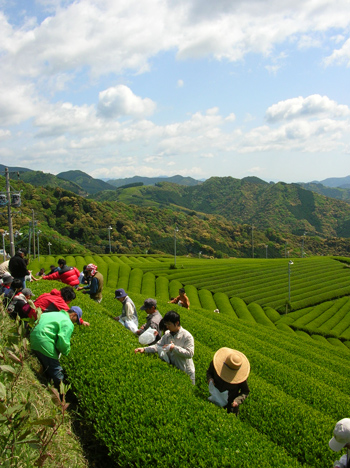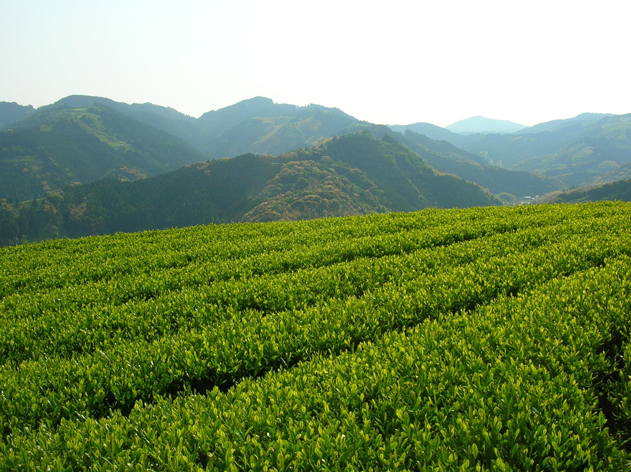Japan’s Dying Trade
by Danielle Rippingale
Like steam rising from a tea cup, the mere mention of Japan naturally evokes romantic images of green tea and the century old traditions that surround this esteemed brew, and with good reason. Japan has a strong history of tea appreciation, with crops of Japanese green tea extending back at least 1,000 years. Japanese Buddhist monks studying in China brought tea and tea seeds back to Japan during the 12th century. It was during the 1400s that tea became a popular drink in Japan, and the tea ceremony with all its intricacies was born. The status of tea was elevated to an art form with the ceremony called cha no yu (hot water tea) by Zen priest Shuko Murata.
All tea, whether black, green or white, comes from the leaf and leaf bud of a flowering plant, Camellia sinensis (sinesis means Chinese in Latin). Different teas are then produced according to different levels of oxidation. The young leaves and bud are most preferable for quality tea production, although the taste of the tea will vary greatly depending on growing conditions, time of harvest, and method of processing. Green tea has minimal oxidation compared with black tea.
Over the last 20 years the health benefits of green tea have been enthusiastically researched, with growing evidence that regular tea drinkers have lower rates of heart disease and cancer than non-drinkers. The free radical-fighting antioxidants (polyphenols, flavonoids, and catechins) that may fight some cancers are highest in white tea, although green tea offers more than the highly processed black tea. Higher quality and freshly brewed teas have more antioxidants (and are better for the environment) than lower quality teas and the increasingly popular bottled teas.
Every tea producing region in Japan grows tea boasting distinct flavors that the Japanese have traditionally honored and celebrated. Preferences for specific tea are influenced by the local culture, food culture, and the natural environment.
Japan produces various types of green tea, and unlike Chinese green teas, which are initially pan-fired, Japanese green tea is first steamed to prevent the leaves from oxidizing, giving the tea a greener color and a grassier and more bitter flavor. The leaves are rolled, shaped and dried before being fired to aid in their preservation and to add flavor.
“Tea… is a religion of the art of life”. ~Okakura
Some of the most common Japanese green teas:
 Gyokuro (Jade Dew tea) is an expensive, high grade green tea with a pale green infusion and distinctive sweet flavor that results from shading the plant before harvest to slow down growth and increase production of amino acids. Forty percent of gyokuro is produced in Yame in Fukuoka prefecture.
Gyokuro (Jade Dew tea) is an expensive, high grade green tea with a pale green infusion and distinctive sweet flavor that results from shading the plant before harvest to slow down growth and increase production of amino acids. Forty percent of gyokuro is produced in Yame in Fukuoka prefecture.
Sencha (decocted or broiled tea) is grown in the full sun, made without grinding the tea leaves, and accounts for over three quarters of all tea produced in Japan. Produced in Shizuoka, the Yame region of Fukuoka, and Kyushu, sencha has a pleasant sharpness and rich emerald color. Sencha tea can be divided into shincha (new tea, or the first sencha harvest), which is high in vitamins, sweetness and full, grassy aroma and flavor; nibancha (‘second tea’), which has a stronger, more bitter flavor; and bancha (‘coarse’ tea from the third harvest), which is considered the lowest grade of green tea and has a strong organic straw smell and bitter flavor.
Hojicha is reddish in color, lower in caffeine, and extremely popular due to the roasted caramel-like flavors that arise from roasting the leaves at high temperatures in a porcelain pot over charcoal.
Genmaicha (brown rice or popcorn tea) is a blend of sencha and roasted brown rice that gives a light yellow color, an aroma of roasted rice, and a mild taste.
Kukicha (twig tea) has a mildly nutty and slightly creamy, sweet flavor. It is made from the stems, stalks and twigs of the tea plant.
Matcha is finely stone ground tencha, or handpicked shade-grown leaves that are dried flat, de-veined and de-stemmed (not to be confused with other powdered tea or konacha). High quality matcha has a deep flavor and intense sweetness. The Japanese tea ceremony centers on the preparation, serving, and drinking of matcha.
More recently, Japan’s tea industry has witnessed significant changes in tea production and consumer tastes, as witnessed with an increased popularity in black tea, which has dominated the market in the West for centuries. Another trend in Japan is the proliferation of cold bottled tea. Not only does the bottled beverage use low quality tea with limited health benefits, but its rising popularity is significantly undermining the ability of tea farmers to make a living.
Ayumi Kinezuka is an organic tea farmer from Shizuoka prefecture, where 40 percent of Japan’s raw tea leaves are produced and processed. She is acutely aware of the challenges—both natural and economic—facing tea farmers in Japan. In their search for good quality tea at the lowest price possible, Japan’s largest and most powerful tea companies exercise strong influence on the market price of tea. With huge purchasing power and a focus on profit, their control of the market makes the production and sustainability of tea farming very difficult for farmers.
“Unlike Chinese green teas, Japanese green tea is first steamed, giving the tea a greener color and a grassier and more bitter flavor.”
While not unique to tea farming, issues like aging farmers, lack of succession, and land abandonment further complicate the situation for farmers in Japan. Kinezuka is adamant that competition from cheap foreign tea imports is less of a concern to Japanese tea farmers than exploitation by the market system. Every year she witnesses farmers being forced to reduce their tea prices to those that are unsustainable. She fears that tea farming, with its local culture, knowledge and techniques, is on the precipice of extinction, as many farmers have no other choice but to abandon their tea fields and end generations of farming.
 Kinezuka feels that we must acknowledge the problem, gain understanding, and act together to find a solution. Here’s food, or tea, for thought—the next time you are sitting down to a cup of tea, consider the implications of your purchase and commit to purchasing quality (ideally organic) tea from local farmers. Also, consider taking a trip out to one of Japan’s tea growing areas to learn more about this important aspect of Japanese culture. Its diminishing size is a big loss to Japanese heritage, as well as to world tea culture.
Kinezuka feels that we must acknowledge the problem, gain understanding, and act together to find a solution. Here’s food, or tea, for thought—the next time you are sitting down to a cup of tea, consider the implications of your purchase and commit to purchasing quality (ideally organic) tea from local farmers. Also, consider taking a trip out to one of Japan’s tea growing areas to learn more about this important aspect of Japanese culture. Its diminishing size is a big loss to Japanese heritage, as well as to world tea culture.
Making a pot of sencha may seem like an easy task, however common mistakes include using water that is of poor quality, too hot, too little, or too much, and over brewing.
How to prepare the perfect pot of sencha green tea:
1. Put leaves in tea pot (approximately 3g per person).
2. Prepare tea cups by adding hot water to 8oz cups until their temperature drops to around 60°C.
3. Gently pour the water from the tea cups into the tea pot and steep for two minutes. The water should be at the same level as the tea leaves.
4. Pour the tea into tea cups and enjoy!
5. For the second serving, you may increase the water temperature to around 70°C, and for the third to about 90°C. After that you can directly pour the hot water into the pot.









